| Reviews & Columns |
|
Reviews DVD TV on DVD Blu-ray 4K UHD International DVDs In Theaters Reviews by Studio Video Games Features Collector Series DVDs Easter Egg Database Interviews DVD Talk Radio Feature Articles Columns Anime Talk DVD Savant Horror DVDs The M.O.D. Squad Art House HD Talk Silent DVD
|
DVD Talk Forum |
|
|
| Resources |
|
DVD Price Search Customer Service #'s RCE Info Links |
|
Columns
|
|
|
Six Feet Under - The Complete Series Gift Set
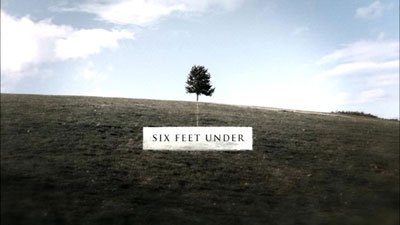
INTRODUCTION:
Death. There is no greater truth, nothing more fundamental to human existence, than our mortality. While many believe in some form of spiritual continuance, we all share one common reality: every single one us is going to die. And yet, as a society, we not only fear this inevitable conclusion of life, we shuffle it off to the sidelines and hide it from view. Our dead are quickly transferred to detached professionals who sanitize the experience for public consumption, and we are encouraged to internalize our grief for fear of embarrassing ourselves or upsetting others. Every day, the emotional impact is trivialized in films and television for the sake of entertainment, and we grow further distanced from our shared reality. Six Feet Under sought to change that, and through a dark blend of comedy and drama, it brought death out of the closet for all to see.
Under the supervision of HBO's Carolyn Strauss, Alan Ball's groundbreaking series took viewers inside Fisher and Sons, a conservative family-owned funeral home in Los Angeles, and showed us all the gory details of the death-care profession. From the physical machinations of cremation, embalming, and reconstruction to the emotional anger and frustration and grief, the 5 seasons collected together in this "Complete Series (2001-2005)" set pulled no punches and examined every aspect of human death, all through the eyes of the dysfunctional Fisher family and their loved ones. What made the series truly special, however, was not its uniquely detailed portrayal of the funeral industry, but its analysis of the human condition and the daily struggles of its rich and dynamic characters. Starting with its electric series premiere, viewers were constantly trusted with difficult subject matter and frequently challenged to re-examine their own perceptions; and by the achingly haunting and memorable series finale, it proved more than just an entertaining diversion, but an eye-opening experience that positively affected the lives of those who watched. Precious few television programs transcend their entertainment value in this manner, and while it was often referred to as a show about death, Six Feet Under will be long remembered as one of television's most poignant and profound explorations of life.
N.B.: It is impossible to adequately review a complete series DVD set without discussing certain key plot points. Every attempt has been made, however, to contain said discussion to the relevant seasonal sections without revealing anything more than necessary.

CONTENT:
Six Feet Under tells the story of Fisher and Sons, a Los Angeles-based funeral home established in 1944, owned for 34 years by family patriarch Nathaniel Fisher, Sr. (Richard Jenkins) Alongside his youngest son David (Michael C. Hall) and gifted restorative artist Federico Diaz (Freddy Rodriguez), Nathaniel has operated the family business on the lower levels of their impressive rural estate, home also to Ruth (Frances Conroy), his conservative wife of 35 years, and their rebellious 17-year-old daughter Claire (Lauren Ambrose). The family has spent much of their lives surrounded by death and grief, but none of them is prepared for the tragedy that strikes them on Christmas Eve in the opening sequence of the series premiere. Test driving the family's brand new hearse on his way to the airport to pick up eldest son Nate (Peter Krause) visiting from Seattle, Nathaniel is hit full-speed by a city bus and killed instantly. This unexpected tragedy is the catalyst that forces the repressed Fisher family to confront their demons and sets the stage for 5 incredible years of dramatic television.
Nate is a free spirit who swore off the family business at a young age and moved away from home the second the opportunity presented itself. While incredibly affable and popular with the ladies, his romantic relationships have been superficial at best, and he has been unable to establish any sense of direction with his life, spending the years just before his father's death as an assistant manager of organic produce for a food co-op in Seattle. At 35 years of age, his life is going nowhere, but as long as he's not a funeral director in Los Angeles, that's good enough for him. With his father's passing, however, he is forced to confront his greatest fear by moving back home and helping his brother David save the family business. To his great surprise, while he abhors everything about the industry and its frequently impersonal corporate nature, he soon learns that he possesses a unique gift for easing the suffering of his grieving customers.
His younger brother is in many ways the complete opposite. Conservatively bound to family duty, David gave up his dream to attend law school and has spent the years since Nate left home preserving the family legacy at his father's side. He adores his older brother and has always looked up to him, but he also harbors feelings of resentment and abandonment, convinced that Nate has been out in the world living this wonderful life while he wastes his own away suffocating in the family business. David has spent his whole life trying to make other people happy, reconfiguring himself to meet what he perceives their expectations of him to be, something that has proved difficult as a homosexual man in a conservative home where emotional discussions about feelings and sexuality are not a common occurrence. As a result, he nearly married an unsuspecting woman and has tiptoed around for years with the crippling fear of how his family would react if they ever found out who he really is.
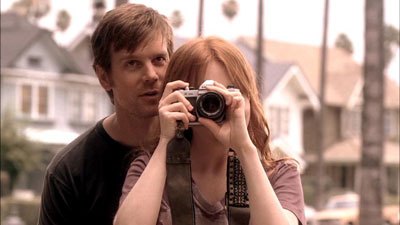
Clarie is the baby of the Fisher siblings, 14 years younger than David and effectively a late-addition outsider in the family dynamic. While certainly not intentional, much of her childhood had a "been there, done that" feel from her parents, and she doesn't have a particularly strong bond with either of her much older brothers, least of all Nate who has been away for most of her life. As the series begins, she is just another angst-ridden teenager, disillusioned with the world around her and clueless as to what to do with her life. She drives to school in the family's previous-generation hearse (repainted lime green for personality) and is wasting away in her high school's out-of-touch stoner community. How screwed up her life has become is brought into focus when she tries crystal meth for the first time on the day of her father's death and has to face the worst moment of her life in a drug-induced state of excited euphoria. She feels so completely out of touch with the world and her family, but in reality, she is very much like her repressed but well-meaning mother Ruth.
-- Claire Fisher
Ruth never had much of a childhood. Her teenage years were spent nursing her dying grandmother, and she was married to Nathaniel and giving birth to Nate at the tender age of 19. She has spent her entire life swallowing her emotions, counseling the grief-stricken who parade through her house as she desperately tries to be a good homemaker for her family. She had many of the same earthy and artistic urges that Claire is starting to embrace, but family responsibilities prevented her from ever truly exploring that side of her personality. Her devotion to creating a Hallmark family dynamic has kept her a tightly wound core of suppressed emotion, but the years of repression unavoidably begin to boil over after the death of her husband brings perspective to her life.
The final member of the family isn't a Fisher at all. Federico Diaz has worked for Nathaniel and looked up to him for paternal guidance ever since the unexpected death of his own father at a young age. Starting off as a kid helping out with various odd jobs around the house, Rico has developed over the years into a talented restorative artist under the tutelage of Mr. Fisher. With a young child and another on the way at the start of the series, he wants to provide a better life for his family, and his ambition leaves him desiring more than restoring bodies for the rest of his life in the basement of a business he doesn't own.
Each of these individuals is profoundly impacted by the death of Nathaniel Fisher, and that impact is illustrated through one of Six Feet Under's signature storytelling techniques: internal dialogues with the dead. Beginning with Nathaniel in the series premiere, each episode opens with a death, and that deceased character often returns throughout the hour as a mental apparition that the living characters use to work through their own personal demons. A promising young athlete passes away in his prime and frequently appears to Nate as a scared whimpering boy, prompting Nate to address his own fears about dying young and the frailty of our human bodies; and when a young gay man is savagely beaten by ignorant homophobes, David cannot shake the battered visage, recalling his own struggle with his lifestyle and the self-loathing that continues to keep him at a distance from his boyfriend Keith (Matthew St. Patrick). Sometimes the dead appear to the living as brief symbolic gestures, and other times they engage in detailed internal debate, but the technique is never gimmicky and provides an excellent way for the audience to step inside the minds of the primary characters. A recurring theme through all of this is Nathaniel, whose effect on the lives of each character is far more profound than they realized while he was alive, and they frequently turn to his memory for guidance and strength, but always through the personalized filter of how each individual perceived him and would expect him to react in a given situation.

To the show's credit, these deaths that open each episode represent an incredible range of possibilities, from the absurd to the mundane, the hilarious to the macabre, the expected to the achingly tragic. Refusing to shy away from uncomfortable subject matter, Six Feet Under addresses the truly difficult deaths like an assisted suicide of a wounded war veteran or two very young parents losing their first child to Sudden Infant Death Syndrome. The show tackles these topics not to be gruesome but because that is simply the reality of the world in which we live, and if this series is about anything, it's about facing our shared reality in all its glory and heartache. Sometimes people die in ways that are painful to watch, and the series maintains a healthy balance between treating the material with dignity while still portraying an honest reality of these horrible circumstances. To keep the show from getting too dreary, many episodes feature some absolutely bizarre deaths that no one would ever expect could happen until reading about it in the newspaper one day, continually reminding the audience that death is a fundamental aspect of life, and it can strike any of us at any time, so we should treasure the time we have.
Another storytelling mechanism used throughout the series that takes us deeper into the mindsets of our characters is their periodic departures into personal fantasy. When Nate is at a hospital speaking to a particularly arrogant double-talking surgeon, we are treated to his internal fantasy, the verbal explosion of rage he would let loose on this obnoxious doctor if he didn't feel socially obligated to maintain his composure. When David delivers an impassioned speech at his church, we witness the standing ovation in his mind before settling back on the reality of mild disinterest from the congregation. These brief interludes are often provided for comedic effect, but they also help the audience understand what the character is thinking at a given time and the motivation for his actions in a particular situation. All of us daydream in our regular lives, imagining what we might say to someone if we could get away with it or dreading a potential negative reaction to an upcoming task, so it is fun to see these daydreams briefly played out on screen through these characters.
One of the more impressive aspects of the show is the incredible attention to detail and its level of trust that the audience can handle such difficult subject matter. Throughout the course of the series we learn just about everything there is to know about the death-care industry, and none of it is sanitized to make it easier to digest. Cremation, embalming, facial reconstruction for open caskets -- it's all here, and it helps us better understand something that happens to all of us and yet we know almost nothing about. More than just covering the subjects, the level of special effects detail is staggering and more than one would really expect from a television series. Consequently, the experience is so tangible and in-your-face that it cannot be ignored and must be dealt with by the viewer.
What truly sets Six Feet Under apart from other shows, though, is how it transcends the entertainment medium and becomes a work of art. I can describe the characters and plot and storytelling techniques for you, but I can never do adequate justice to just how effective the series is at conveying its themes about life and death and how its impact stays with you long after you've watched an episode. That the overall product becomes greater than the sum of its parts is a remarkable achievement when you consider that you will not find better "parts" (acting, writing, direction, etc) anywhere else on television. In fact, the artistic merit of the series is so high that I feel unworthy sitting here trying to put it into words, because you cannot capture something like this through description. It's just too special, and it has to be seen. It has to be experienced.
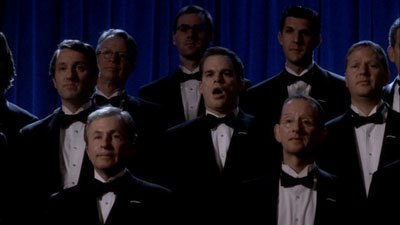
SEASON ONE: 
-- Nathaniel Fisher
As mentioned, Six Feet Under begins with the death of Nathaniel Fisher at the open of the darkly comedic pilot episode. His death sends ripples throughout the family, forcing David to step up and take control of the business and prompting Nate to stay home and help out instead of returning to his easy life in Seattle. In this first episode, we are introduced to Brenda Chenowith (Rachel Griffiths), a sexually aggressive and self-destructive woman Nate meets on his plane flight home and has sex with in a broom closet at the airport. Brenda is brilliant, a child prodigy who was raised by dysfunctional wealthy psychiatrists and was the subject of a famous psychological examination and subsequent book in her youth. Had she not been around to drive Nate to the morgue and share this deeply emotional experience with him, it's unlikely the two would have ever seen each other again, but now they are forever linked by this defining moment in his life.
We also meet Keith Charles, a police officer David is dating in secret. Keith is a good person who has genuine feelings for David, but he cannot deal with the way David constantly apologizes for his lifestyle, unable to accept who he is or even come out to his family. The relationship between these two is probably the most endearing and honest throughout the entire series, but it is merely in its infancy in this first season, as David has a lot of growing to do as a person before he can be with someone like Keith. Much of this first season is devoted to David's personal journey to accepting himself as a person.
In many ways, the pilot episode sets the tone for the entire 5-year run, but it does feature a few unique traits that would not appear again. The most notable of these is the numerous advertisements for funeral industry products. Throughout the episode, during transitional scene breaks, viewers are treated to hilariously insensitive television commercials for various products that might be featured in the death-care profession and are subtly used by the Fishers in the episode itself. Items like "Living Splendor Embalming Fluid" and "Spill-Free Earth Dispenser" are jazzed up in sleek and offensive advertisements that illustrate how corporate and detached the industry has become. These bits are incredibly funny, albeit somewhat disturbing, but they would not be featured in future episodes.
This first season covers a few specific plot points. Nate is learning the funeral business after years of running away from it, and through him, the viewer learns all the beautiful and creepy details of the industry. Nate also finds that he is learning a surprising amount about his father's life now that he's gone, addressing issues we all face about never getting to know someone until its too late. Federico sees Nate's return to share ownership of the business and begins to question his own future, investigating a potential embalming position at Kroehner International, the cold mega-corporation looking to take over all the small family-owned funeral homes in the region.
The season represents an initial growing period for the characters as they face life without Nathaniel and for the show itself as it settles on the style it will maintain throughout the series. Starting out of the gate with such an incredible pilot episode, the bar is set quite high initially, but each subsequent episode delivers taking us deeper into the lives of these fascinating characters. By the season finale, the compelling themes about life and death have been effectively established and book-ended very well, leading the viewer to wonder where the series will go and if it can possibly maintain the high level of quality established by its first 13 episodes.
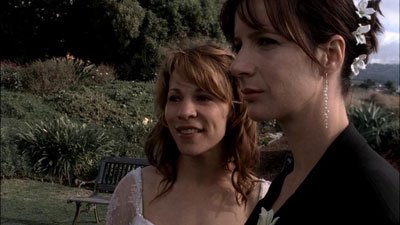
SEASON TWO: 
Nate Fisher: To make life important."
With the newness of this unique show wearing off, the second season needed to provide even more depth of story to maintain the momentum established in the first, and this second batch of episodes completely delivers a high level of quality that may even be better than the preceding effort. As the season begins, Nate learns of an arteriovenous malformation (AVM) in his brain that could be fatal but could just as likely never bother him for the rest of his life. His struggle with this newfound mortality consumes his journey this season, and he begins to explore the more spiritual sides of his personality. With Brenda being an overly intellectual atheist, their differing outlooks on life put strain on their romantic relationship. Nate is an optimist, always wanting to be better than he is and believing in more than our corporeal existence. Brenda, on the other hand, is convinced that this is all there is, and her contented pessimism does not mesh well with Nate's spiritual awakening.
Brenda is also dealing with her own personal issues. Having to commit her close brother Billy (Jeremy Sisto) to a mental hospital at the end of the previous season has taken its toll on her, and as her relationship with Nate endures longer and grows closer than any romantic relationship she's had before, the subconscious fears that she isn't good enough and can't handle a normal future begin to creep in, and she acts out in sexually destructive ways that threaten to destroy what they have together.
For Claire, this second season brings her out of the typical rebellious teenager role and into that difficult transitional period where she has to start thinking about what she wants to do with her life. As she sees everyone around her taking the SATs and preparing to go to college, she can't help but be disenchanted with the whole experience, convinced that she already knows everything that school has to teach her. She is, however, starting to become more involved with creating artwork, and that helps to establish some actual desire and passion for something more in her life, perhaps for the first time since she was a child.
This second season also takes us more into the pasts of many of the main characters. A road-trip to pick up a body in Seattle returns Nate to his old stomping grounds, and we meet for the first time Lisa (Lili Taylor), a radiantly indefatigable spiritual presence from the life he left behind. We also meet Ruth's sister Sarah O'Conner (Patricia Clarkson), who is the artistic free-spirited antithesis of the bottled-up Ruth. The relationship between Sarah and Ruth echoes in many ways the divergent paths of Nate and David. Outside of the main stars of the show, the casting of Taylor and Clarkson in these roles is absolutely brilliant, and each of them adds so much to the show in this and following seasons. Finally, we learn more about Keith's home-life through the introduction of his troublesome but good-hearted niece Taylor (Aysia Polk), who is being raised by Keith's drug-addicted and undependable sister.
One of the great things the second season does is begin to provide some very small but incredibly touching moments between the Fishers. Each of these characters pretty much lives his or her life in isolation from the others. They share a house and may eat a meal together periodically, but they rarely talk to one another about anything meaningful. It's because of this frequent separation that when Claire tries to comfort her mother or when Nate shares his fears about death with David, it is incredibly touching in a way very few shows can achieve. These people feel like a genuine family, and it is all too easy to identify with their struggles. By the end of this season, it is clear the quality of the first was not a fluke and that Six Feet Under is more than some quirky dark comedy, but one of the best things to hit television in a long time.
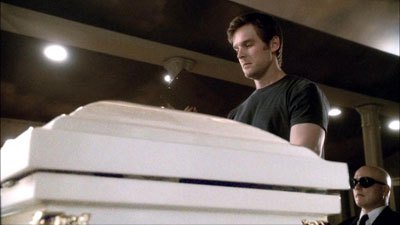
SEASON THREE: 
-- Nathaniel Fisher
By the time the second season finished airing, Six Feet Under had established itself as a legitimate hit on HBO, with a dependable formula that was embraced by critics and viewers alike. Not content to rest on their laurels, what would happen next surprised the critics and frustrated many of the loyal viewers of the show, as the writers made a series of bold creative choices that took the series in completely unexpected directions. Many have debated the success of these choices, but in my opinion, they elevated the show from entertainment to art and produced one of the most compelling and insightful seasons of television I have ever seen.
The third season begins with "Perfect Circles", a bold journey into one of quantum physics' most fascinating mysteries. At subatomic levels, the physical act of observing a particle's position changes that particle's momentum, leading us through what is known as Heisenberg uncertainty and ultimately the wave-particle duality of matter. Most of us learned this in high school physics and probably even set up our own double-slit experiments to illustrate this amazing phenomenon. Taking it a step further, though, conventional wisdom theorizes that a particle exists as a wave-form probability until it is observed, and only after its observation does it "decide" its position and begin to truly exist. What does that have to do with Six Feet Under? Well, there is a famous thought experiment proposed by Erwin Schrödinger that seeks to demonstrate the inherent absurdity of what we've come to accept as reality: in theory, one could design a box where an unsuspecting cat's life is held in the balance by the wave-form probability of a radioactive isotope attached to a vial of poison. In such a case, the cat would technically be both alive and dead until someone opened the box to check on him. "Perfect Circles" takes this fascinating thought experiment and weaves it into the fabric of the overall story, creating a compelling examination of choice and the nature of our own humanity. That a show of this nature would even attempt an episode like this is jaw-dropping. That it would be so successful in its attempt is absolutely remarkable.
This premiere episode sets in motion most of what this third season will be about, and it is a darker season to be sure, really testing the strength of the characters we've come to know and love. One of the driving themes of the season is the way people inevitably turn into their parents. Nate has spent his life trying to avoid becoming his father, but as events play themselves out, he unsuspectingly falls into the exact same patterns as Nathaniel. He's trying so hard to be a good person and do what society expects of him, but that effort is suffocating his personality and leading him down the same paths as his father. David struggles with the other side of it, trying to avoid being a doormat like his mother. Where this becomes difficult for him is the contradicting anger issues that Keith inherited from his father. Keith and David love each other very much, but finding a way to live with each other amongst these issues is a continued source of emotional pain for both of them.
For Claire, the issue is less emotional and more specific. Ruth never went to college, never pursued her dreams, and if she gets one thing right with her children it will be ensuring that Claire receives some form of higher education. Beginning her first year at LAC-Arts, a local arts college, she starts to finally grow into herself as a person and realize that artistic expression may be her one true passion in life. Unfortunately, this experience also drags her into the politics and hypocrisy of the art education community, and she struggles to find her own voice as an individual, not just another above-it-all elitist. Through her art school classes, the audience gets a rarely seen glimpse into what the artist-to-be goes through and how the whole process could drive one towards insanity.
The third season is also a significant one for Rico, whose seemingly perfect family life is starting to show cracks of its own, and the Fisher-like problems he never thought he'd have to face creep into his own life. His wife Vanessa (Justina Machado) is mired in depression after the death of her mother, and his increased responsibilities at work have created more emotional stress that he cannot shake when returning home.
Darker in tone, the third season challenges the audience more than ever and is by far the most daring of the five. It starts where one would never expect it to start and concludes where no one expects it to go, and by the end it stands apart as a uniquely artistic and thought-provoking block of television that really makes us think about our lives and the nature of our humanity. Watching it for this review was the sixth time I've seen it in its entirety now, and it continues to maintain its strength as a truly special part of our television heritage.
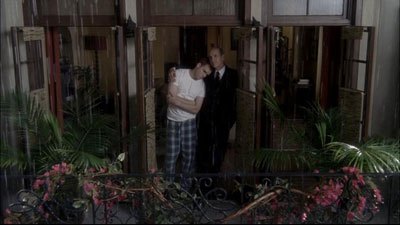
SEASON FOUR: 
-- Nathaniel Fisher
Season Four is the first time Six Feet Under begins to dip in quality. It is the darkest of the seasons, and it really puts our characters through the wringer, but at times, it pushes them a bit too far and doesn't carry the same realism and truth as previous seasons. To be fair, the bar was set so incredibly high that it would be near impossible to meet in the first place, and for all of this season's problems, it's still dramatically better than most anything else you're going to watch. It's just not as good as what came before.
There is a lot of heartache in this season and some stories that seem to come completely out of nowhere. For Nate, the loss of Lisa is difficult to bear on its own, but the knowledge that he wanted her out of his life in the first place continues to haunt him and keeps him from being any kind of responsible parent to Maya. The one good result of the seemingly Job-like trials he has faced is that he slowly finds his way back to a search for spiritual enlightenment, a desire to be more than himself.
A lot of time is spent on Ruth and her recent marriage to George Sibley (James Cromwell). At times it presents some interesting drama, but it slowly descends into some very strange territory and by the end of the season you wonder where the hell this storyline came from. Also coming out of nowhere is a bizarre car-jacking episode with David. One of the running themes in the series has been how life can run up behind you and kick you in the ass when you least expect it, but some of it is just too much for the characters and the audience to endure. David and Keith have always had the most compelling relationship on the show, but the problems that stem from this freak occurrence are more annoying than interesting.
Even though it has its problems, there are two standout episodes in this season: "Parallel Play" and "Untitled". The former refers to the way children at a young age will play next to each other instead of with each other, and the latter references Claire's reluctance to name her first successful piece of art, because once you give it a name, you define what it is supposed to be. The final act of the season finale is a definite WTF? circumstance, but it is surprisingly effective all things considered, and the final moments with David and his father looking out into the rain are absolutely beautiful.
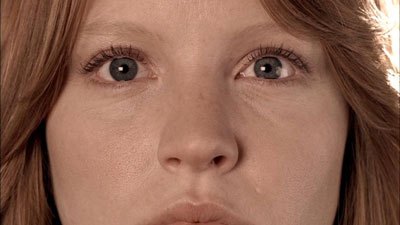
SEASON FIVE: 
-- Nate Fisher
The fifth and final season of Six Feet Under was promoted with the following tagline: "Everything. Everyone. Everywhere. Ends." But inherent to those endings are new beginnings, and thematically this season is not just about conclusion, but transition and building for the future. For Nate and Brenda, it's raising Maya and having a child of their own together. For Keith and David, it is also about raising children, in their case two adopted young boys who have spent their childhood bouncing between foster homes. For Rico, it's realizing just how important his family is to him and what he'll do to help it survive. And for Claire, it's finally growing up and becoming a real woman, a journey that ends up being beautiful to watch.
Because there was so much darkness in the fourth season, this final effort takes some time to find stability, and the first few episodes are merely okay. But once the closing threads of this last season start to fall into place, the race to the finish line is incredibly strong. Perhaps the best story of the season is that of Claire. She experienced some artistic fame in the previous season and is looking to recapture that, but she has to face the reality that the public has moved on to the next big thing and her fear that her one stroke of brilliance may be the only great thing she's ever going to do. In some of the funniest and most endearing scenes of the entire show, she is forced to get a "normal" job, collating documents and other mundane tasks at a stuffy corporate law firm where her coworkers make frequent and obnoxious pop culture references and embody every cliché she's ever imagined about the blissfully common American. Ironically, though, this job allows her to meet the deeply unhip Ted (Chris Messina), a conservative Republican who listens to Top 40 stations and Christian music and may just be the best thing that will ever happen to her.
This is also an effective season for Ruth. Since the death of her husband five years prior, she has been a mess, struggling to cope with all the repressed emotions that she can no longer contain. Life has hit her particularly hard, but she keeps getting back up, stronger each time, and even after she is knocked down a few more times in this season, we feel like she's found enough inner strength from the help of friends like Bettina (Kathy Bates) and Robbie (Joel Brooks) that she just might make if through the series okay.
The task of ending a show as compelling as Six Feet Under had to be incredibly daunting, but somehow the writers completely nailed it. The three penultimate episodes -- "Ecotone", "All Alone", and "Static" -- are absolutely fantastic, so emotionally resonant that one has to hit pause and remind himself that this is just a television show. But it's the series finale -- "Everyone's Waiting" -- that truly stands out as one of the most impressive final episodes ever aired on television. It is so brilliantly put together, so emotionally haunting long after it's over, and so wonderfully in keeping with the themes of the series as a whole that no words can ever do it justice, and I won't presume to attempt so here. Simply put, it is perfect.

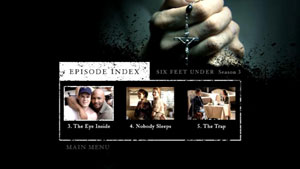
PRESENTATION:
"Six Feet Under - The Complete Series (2001-2005)" is packaged in a unique collectible set evocative of the show's creative style. Each season is spread across 5 discs (4 in the case of Season One) that sit in a standard 5-panel foldout casing. Episode descriptions and photos adorn the various panels, with particularly beautiful artwork for the final season. These casings line up next to each other and slide into the front of a larger enclosure via an opening front panel that is hinged at the top. On the inside of the front panel is a rendering of the primary cast members as if they're being viewed from within a buried coffin. The overall enclosure is cleverly designed to appear as a funeral plot, decorated to look like underground dirt with roots seeping through the top and elevated faux grass growing from the roof. A low-profile gravestone marks the plot: "Six Feet Under - The Complete Series (2001-2005)". While it is a tad fragile, it is very creative packaging and entirely appropriate for the series. One note that is probably obvious: the awkwardly oversized original release of the 1st season has been properly sized down to match the others in this set.
At this point, it's a little silly to review the audio and video quality of these HBO releases. They set the standard years ago and have continued to match it with each subsequent release. As expected, the video quality on this set is near perfect, free of any noticeable artifacting or edge enhancement and almost completely devoid of distractingly grainy outdoor sequences. The first two seasons are presented in full frame 4:3, while the final three are 16:9 anamorphic widescreen.
Audio is wonderful as well. It is crisp and clean with no annoying variance between different scenes. The occasional special feature is slightly softer than the main presentation, but it is the kind of thing I only mention to fill space in this review. It's unlikely the average viewer will even notice or care. Tracks are offered for English 5.1, Spanish 2.0 and French 2.0. Subtitles are provided in English, French, and Spanish as well.
As for the menus, with the exception of the first season, they are exactly what they should be. Episodes are accompanied by brief summaries, and the "Previously On" and "Next On" segments have been thankfully split off into their own separate tracks, since anyone watching the series straight through will have almost no interest in them. The only drawback is the first season where the episode selection screen plays video clips from the various episodes in the background. While this may have seemed clever to the DVD producer at the time, all it does is spoil some of what is going to happen in those episodes. Recognizing their mistake, these clips do not appear in subsequent seasons.

WHISTLES & BELLS:
HBO sets are notoriously thrifty with the special features, but there is still some very good material on this set.
SIX FEET UNDER: IN MEMORIAM
The one bonus feature unique to the box set is a beautiful 18-page booklet that features artwork and obituaries from the series. It looks great, but unfortunately it is very fragile, and had my booklet not already separated from the cover during shipping, I would expect it to after opening it a few times anyway. Included inside are both of the original CD soundtrack releases: "Six Feet Under: Music from the HBO Original Series" and "Six Feet Under Volume Two: Everything Ends". What's wonderful about these two discs is how each represents a completely different side of the show. "Volume 1" illustrates the rebellious quality that Six Feet Under displayed when it burst on the scene in 2001 and represents the eclectic countercultural soundtrack behind the lives of characters like Claire, Nate, and Brenda. Probably overlooked by many is a great 10-page insert that features some of the best stills and quotes from the show's incredible first season.
"Volume 2" takes a different approach. Whereas the first disc centers around our characters, this entry is more emotionally tied to the series as a whole. Coldplay's "A Rush of Blood to the Head" transports us back to the brilliant "Perfect Circles", Radiohead's "Lucky" is evocative of the achingly effective final sequence in the fourth season's "Parallel Play", and Death Cab for Cutie's "Transatlanticism" captures Claire's artistic experimentation from the same season. And then there's Sia's "Breathe Me", which no person who has seen the final episode "Everyone's Waiting" can listen to without experiencing an overwhelming rush of emotion. Finally, there's a wonderful bonus track that perfectly closes out the disc: "Lonely Little Petunia" by Imogen Heap.
|
|
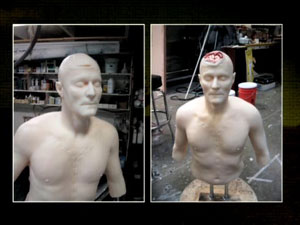
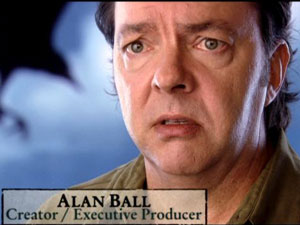
FEATURETTES:
- "Under the Main Titles" (15:47): An interesting look at the main title sequence created by DigitalKitchen to accompany Thomas Newman's haunting title music.
- "Season One: Behind the Scenes" (21:39): Interviews with cast members about the structure of the series and the themes being presented. It starts off as a typical promo piece but ends up having quite a bit of insightful comments from the performers. It is clear they understand what the show is trying to achieve.
- "Anatomy of a Working Stiff" (20:37): A very cool little mini-documentary on the way corpses are created for the show by MastersFX. The quality and depth of information here reminded me of the features on the Lord of the Rings DVDs. With the exception of the squeamish, I think anyone would enjoy this.
- "Living on the Ledge: A Bird's-eye View of the Third Season" (13:52): Behind-the-scenes on the creation of HBO's stunning third season promo. I thought this was great and wish they had done one for the other creative promos.
- "Cut by Cut: Editing Six Feet Under" (18:34): A detailed look at the editing process, specifically the wonderful fourth season episode "Parallel Play" and how the creative choices made after filming can transform an episode into something greater than it was when they began.
- "Costas Plus: Cast Interview" (15:42): Bob Costas is arguably our greatest living sportscaster, but here he's a bit out of his element. I was really expecting a lot from this piece, but it's mostly just a laid back discussion without much substance.
- "Life and Loss: The Impact of Six Feet Under" (27:55): Interviews with actual death-care professionals on how accurate the show is technically and how they have seen a noticeable change in customers' perceptions about death since the show started airing.
- "Six Feet Under: 2001-2005" (45:58): Aired in two parts on HBO in anticipation for the series finale, this is a wonderful retrospective piece that covers most every aspect of the show, from its creation to its conclusion. If you only want to watch one featurette on the set, this is probably the one.
DELETED SCENES:
Scattered across the discs are some deleted scenes, but they're not particularly interesting. With a show like Six Feet Under that airs on HBO without rigid time constraints, it's rare that anything will get cut from an episode if it actually belongs there. As such, these "deleted scenes" don't do much for the audience, and there aren't that many of them anyway. On the first disc of Season One, there is a scene (1:35) that shows Claire and Nate driving to the grocery store in the pilot episode. It has two commentary tracks with Alan Ball, but there is enough dead air in both that I'm not really sure why there isn't just one.
On the last disc of Season Three are three deleted scenes (3:28), one each from the episodes "Nobody Sleeps", "Everyone Leaves", and "Death Works Overtime". If any of them is worth watching, it's probably the second one, which features some heart-to-heart between Nate and Rico. Finally for Season Five there are three more deleted scenes (3:04) from the fourth episode, "Time Flies". There's not much to say about them other than they should have been deleted.
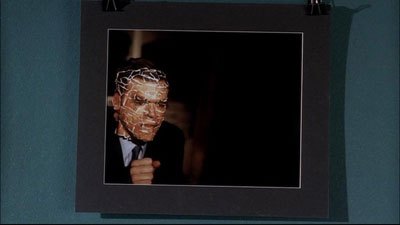
BONUS MUSIC:
As a somewhat transparent attempt to sell soundtrack CDs, something that doesn't make sense anymore with this box set, remixed versions of the title theme can be found on the final discs of Seasons One, Four, and Five. For Season One, there is the original "Title Theme" and "Kid Loco's Gravebeat Mix". On both Four and Five, the "Fila Brazillia Remix" is provided.
AUDIO COMMENTARIES:
Audio commentaries can be found on numerous episodes in this set, and their quality is all over the map. Alan Ball is often the most interesting to listen to, but he can become a bit repetitive in the latter seasons. Fortunately, almost every important episode is accompanied by an audio commentary. Recently I've seen some sets where the show's most important episode was bare, either because the studio wanted to rush the set to the stores or the writer/director felt too emotional about it to add comment. To our benefit, with the exception of "Perfect Circles", that is not the case here. If I had to sift through all of it and select a few that I would recommend to picky viewers, I'd suggest "Pilot", "I'm Sorry, I'm Lost", and "Everyone's Waiting" with creator Alan Ball, "I'll Take You" with writer Jill Soloway, "Nobody Sleeps" with Alan Poul, and "Falling into Place" with writer Craig Wright.
|
| ||||||||||||||||||||||||||||||||||||||||||||||||||||||||||||||||||||||||||||||||||||||||||
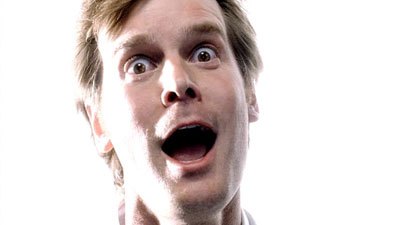
CONCLUDING THOUGHTS:
Recently, I have been watching dramatic television and wondering where the magic went. There are some good shows out there, but hardly anything that grabs ahold of my insides and refuses to let go until the hour is over. I even started to question whether it was me, wondering if perhaps I was just getting old and cranky. Re-watching these five seasons, I see quite clearly that it isn't me. Shows like Six Feet Under have simply set the bar so incredibly high that finding anything that remotely compares is a near-impossible task. The writing is insightful, with meaning that transcends mere television drama; the direction is inspired, as if each hour-long episode is its own short-length feature film; and there is no series that can boast better performances than those given by this absolutely stellar cast. I enjoy all kinds of shows, and I consider many of them to be fantastic at a level of can't-miss appointment television deserving of high praise; but it's only the rarest of shows that I can claim to truly love. I fell in love with Six Feet Under, and as I stare at this set and listen to its beautiful music, I find it hard to believe anyone else could watch it and not have the same reaction. There are a lot of words in this review, so I'll keep this simple: television does not get any better than this. DVD Talk Collector Series.
|
| Popular Reviews |
| Sponsored Links |
|
|
| Sponsored Links |
|
|
| Release List | Reviews | Shop | Newsletter | Forum | DVD Giveaways | Blu-Ray | Advertise |
|
Copyright 2024 DVDTalk.com All Rights Reserved. Legal Info, Privacy Policy, Terms of Use,
Manage Preferences,
Your Privacy Choices | |||||||











